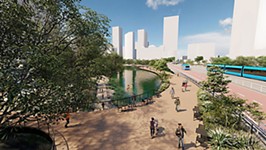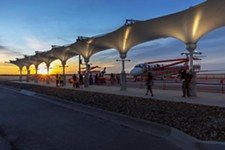Austin at Large: Back (and Forth) to the Future
At some point Austin history will stop looping upon itself. Until next time …
By Mike Clark-Madison, Fri., March 17, 2023

My editor broke the news in her column last week, but this is my last issue for … let's just say a while. I'm starting a new job, working for the government, but I left the Chronicle before and then came back, so who can say what will happen. If you were one of those people who thought it was God's plan that I returned to the Chronicle in 2018 so I could document my friend Kirk Watson's return to City Hall in 2023, sorry about that. I imagine many of y'all can understand why the reset of Austin's news clock back to 1998 did not leave me inspired and enthusiastic – not because Watson (and Jesús Garza, and the whole band they've gotten back together) are going to ruin the place, but because I literally did this same job 25 years ago. Sounds like an exit cue to me!
But, but, but, institutional memory and understanding nuance and all that. Just remember that I learned what I know about Austin policy and politics by the daily (really, 24/7) work of being a news reporter, so anybody who wants to take that work on can look forward to the reward of Knowing Things in subsequent decades and then helping the endless throngs of new Austinites orient themselves to the city.
50,000 People Every Year
When I moved to Austin in 1988 the metro area had around 550,000 people. When Watson was elected mayor the first time nine years later, the metro area was close to 800,000, which is a huge jump in percentage terms, reflecting a steady annual growth rate of around 4.8%. That rate dipped about a half-point in 2001 with the dot-com bust, then held steady for the next 18 years or so, and now the metro area is home to 2.3 million people. Central Texas keeps adding between 50,000 and 75,000 residents a year, but that is now a rate of growth that's substantially slower than it was during my first 30 years as an Austinite, from an ever-larger base.
There really is no contemporary American city, not even in Texas, that has grown as much, as fast, for as long as Austin. Indeed, I'm using metro-area rather than city-limits population because Austin proper is maxed out and full up and expensive AF with its massive housing shortage, barely growing at all since 2020 and stuck under 1 million residents, at No. 11 in the largest-U.S.-cities table; the new 50K-75K Central Texans each year (on net) are now going straight to the suburbs. They're still close enough to take advantage of Austin's unique attractions and opportunities, and to take upon themselves the everyone's-a-winner Austin ethos. But the decline in the regional growth rate is not just a statistical artifact; fewer people are going to come here and stay here if they can't actually live in Austin.
But Why Is That a Problem?
As much as we loooooove to complain about the effects of so much growth so fast for so long, the effects of population decline are much worse and Austin is a long way from that outcome. The problems with a long spell of market-induced growth rationing are pragmatic for certain employment sectors, particularly public-sector jobs with little wage flexibility like 911 call takers, but others might enjoy a spell of only growing 2% each year instead of 5%. However, such thinking is immoral and unethical, sorry to harsh the buzz. Who gets to decide who stays and who goes and who never comes? Elon Musk? Kirk Watson? You?
The immorality comes in many forms. It is the height of irresponsibility to say that we should grow more slowly, and in a way that intensely harms the planet, because we have run out of places where we can build big apartment buildings far from affluent homeowners who have exquisitely rationalized their desire to discriminate, and to live in homogenous environs, into the horrors of the Austin Land Development Code. This has for generations purloined resources and power and opportunity from poorer and younger and not-as-white Austinites who are still, simultaneously, encouraged to move here, go to college, make music, get a midskills job, teach the children, take care of the garden, wait on tables. If Austin wants to be a place with a stable, slow-growing, aging, and increasingly white and affluent population, it has the right policies in place but the totally wrong brand.
To align the policies with the brand, official Austin needs to do about 50 times more hard work than it ever has to create a Vatican II-level program of change – not just rewriting the land use code or doling out a fixed stream of subsidy funds, but hardcore moves like seizing surface parking lots and one-story strip malls via eminent domain so we can build apartments there. (Ironically, that's not as politically difficult as rewriting the code, and the mayor has some interesting powers here, hint hint, says the former chair of the city Urban Renewal Board.) Luckily, many such places will be in the transit station areas that must be rezoned and rebuilt if we want the feds to come pay their share of Project Connect. Watson's on top of that, right?
Got something to say on the subject? Send a letter to the editor.








